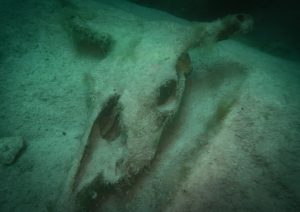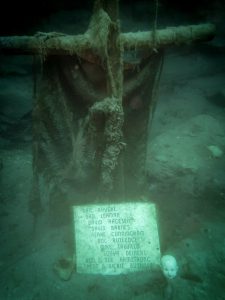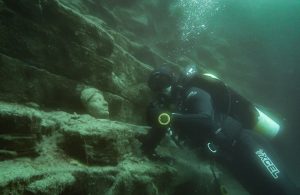 There is no greater pleasure for me than in diving, and in sharing my passion with others. Last weekend, I drove nearly 23 hours into the desert to dive America’s “Blue Hole” – a sinkhole that is part of the underground water systems in the American Southwest. The Blue Hole is located in Santa Rosa, New Mexico, near a lake-turned-water-park.
There is no greater pleasure for me than in diving, and in sharing my passion with others. Last weekend, I drove nearly 23 hours into the desert to dive America’s “Blue Hole” – a sinkhole that is part of the underground water systems in the American Southwest. The Blue Hole is located in Santa Rosa, New Mexico, near a lake-turned-water-park.
It is a popular swimming hole for families, who find the 64F water temperature refreshing amidst the 96F air temperature. We brought our own gear, which we were able to leave on one of the picnic tables immediately next to the Blue Hole.
Cost
There is a $5 parking fee. You are required to have a dive permit ($20 for the week is the cheapest option). Tank fills are $8 a piece.
Amenities
There are indoor and outdoor restrooms available. There is no food or water immediately available for purchase. There is little shade available in the form of a covered pavilion set approximately 200 feet away from the picnic tables and the shade of a tree.

Entry
The two entry points into the water are a three foot drop off a ledge via giant stride, or a concrete staircase that leads you to an underwater ledge approximately five feet deep.
Early in the morning, the site was empty except for scuba divers participating in a class. Closer to lunchtime, the area was quickly filled with families and teenagers eager to use a higher jump off point into the hole. The stairwell in particular becomes quite crowded, although the majority of individuals were willing to move aside to make room for divers to transit.
Descent
The site has a sloping ledge immediately at the base of the stairs leading into the water. The first ledge is concrete, and extends no more than four to five feet past the wall surrounding the edge of the dive site. It then drops vertically to approximately 15 feet, sloping down to 20 feet before dropping vertically once more – this time to the bottom.

The Blue Hole has three locations for divers to descend via a visual reference line:
- One near the stairs
- One near the giant stride entry point
- One on the far side of the hole, near the higher jump off point
The orange buoy nearest the stairs and ledge has a white PVC pipe at 15 feet, making it perfect for a safety stop. The other two white buoy systems have white PVC pipes that form a square at approximately 20 feet and 30 feet, before the four lines on each converge into one line and reach the bottom.

Of course, a free descent is always an option. While visibility is around 50 feet, it does not stretch from surface to bottom, nor from side to side, so using either a line or the wall is recommended for visual reference.
Visibility and Water Composition
The walls and bottom are lined with a slightly translucent slimy algae growth, which is easily knocked off by either the swimmers at the surface, or by a fin kicked too close. By our second dive, visibility had decreased from about 50 feet to approximately 30 feet. At the bottom (75 feet deep), it was darker but not dark enough to merit the use of a flashlight. Cloud cover played a large role in terms of natural light.
The sinkhole is freshwater, so you will be less buoyant than normal if you’re mainly a saltwater diver. (This means use less weight than you would given the same kit and same water temperature in saltwater)
What You’ll See
The walls are perhaps the most novel aspect of this site, as they mimic the texture of the desert plateaus you must drive past to get to the dive site. While no fish are in this sinkhole, there are objects that have been placed at the bottom. We saw:
- Animal skull
- Fake grave with cross and tombstone
- Doll’s head
- Two statue faces of women
- A small cannon



Unique Factors to Consider
The dive site is located at 4,600 feet of altitude, making it an “A1” altitude dive. This was my first dive at altitude, and although we did not take the PADI Altitude Diving Specialty course, we did do our homework. The pressure groups at altitude are different, and our takeaways were that
-
- You cannot dive immediately upon reaching altitude
- Your theoretical depth at altitude is equivalent to a deeper depth at sea level (i.e., 70 feet actual is equivalent to 84 feet theoretical)
- You should ascend at half the normal rate
 And remember to always log your dives! This becomes useful when pursuing higher level certifications, where you need to provide your (signed) dive log as proof of experience.
And remember to always log your dives! This becomes useful when pursuing higher level certifications, where you need to provide your (signed) dive log as proof of experience.
Amenities in the Town
 Santa Rosa is a small and sparse town, mostly suited for truck drivers and families road tripping across the desert and needing a place to stay for the night. The food is nothing fancy, but it hits the spot after a day of diving.
Santa Rosa is a small and sparse town, mostly suited for truck drivers and families road tripping across the desert and needing a place to stay for the night. The food is nothing fancy, but it hits the spot after a day of diving.
We ate at the Route 66 Restaurant, where the diner-vibe gave us the feeling of stepping back into the past. The large juke box next to the doorway and the 25-cent bubble gum machine, as well as the checkered floors and simple hearty meals, erased time from our minds. We were suspended in an era where families stopped in for a bite to eat, listened to old country music, and enjoyed a Coca Cola before hitting the dusty roads once again. I highly recommend their apple pie.
Other locations of note in the area include:
- Family Dollar
- Dollar General
- Food Mart
- A few truck stop gas stations
- McDonald’s
- Another Mexican-American restaurant down the road
Overall Review of the Dive Site
The Blue Hole is a novelty dive, great for training, and accessible for all levels of divers.
 Santa Rosa’s Blue Hole is A-OK! (Thanks to my dive buddy Keith for being such a good sport about driving into the middle of nowhere to dive!)
Santa Rosa’s Blue Hole is A-OK! (Thanks to my dive buddy Keith for being such a good sport about driving into the middle of nowhere to dive!)